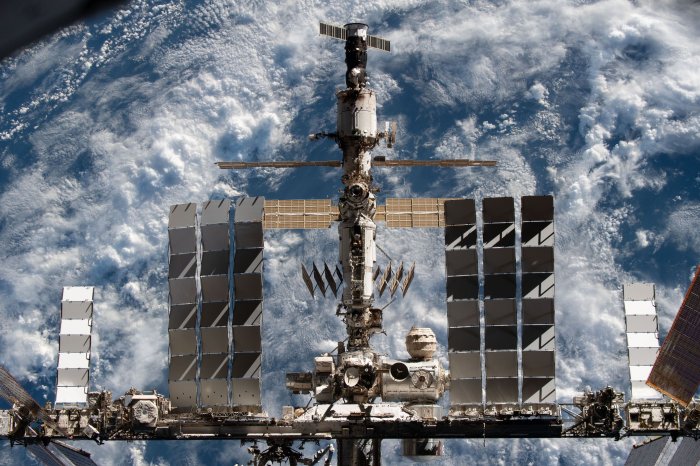1 of 8 | NASA's first Space Launch System, or SLS, rocket and Orion spacecraft roll from the Vehicle Assembly Building toward Launch Complex 39B on Thursday. SLS will be used to launch crews to the moon and beyond in the Agency's Artemis Program. Photo by Joe Marino/UPI |
License Photo
ORLANDO, Fla., March 17 (UPI) -- NASA's towering moon rocket, the SLS, emerged from its assembly building at Kennedy Space Center in Florida on Thursday, providing a new look at the agency's biggest space vehicle since the Apollo era.
NASA held a day of events and media opportunities at the space center leading up to rollout a little before 6 p.m. EDT. The rollout comes as NASA prepares to mark the 50th anniversary of the Apollo 16 mission, which launched April 16, 1972.
The rocket's journey from the vehicle assembly building to Launch Complex 39B took nearly 12 hours, with the SLS finally arriving around 5:30 a.m. EDT on Friday.
Thousands of onlookers gathered along the route of the rocket ahead of its rollout Thursday evening, including NASA employees, contractors and their families. The white and orange launch vehicle, topped with the white capsule and abort structure, slipped slowly past the crowd atop its tank-treaded mobile platform.
The historic importance of the moment is plain to astronauts and everyone working on the massive rocket, astronaut Randy Bresnick told UPI in an interview Thursday at the space center.
"To see this magnificent beast come out of the spacecraft cocoon, so to speak, to emerge from a building built for moon rockets -- that's exciting and so important," said Bresnick.
Bresnick flew on the shuttle Atlantis in 2009 and on a Russian Soyuz capsule to the International Space Station. He's not assigned to any flights on SLS but he said all astronauts hope for the chance.
He said the space shuttle was an awe-inspiring vehicle, but was much shorter than the Apollo rockets, whereas SLS is only about 40 feet shorter than the Apollo-era Saturn Vs.
"Overall, I expect the ride on SLS will be smoother than the shuttle because the shuttle had wings, and was mounted on the side of the fuel tank," Bresnick said. "SLS will be bumpy as the solid boosters fire, but after that, it's just an aerodynamic capsule and abort module on top of the fuel tank."
If all goes according to NASA's schedule, the rocket will remain at its launch pad, Complex 39A, until a fully fueled rehearsal in early April. NASA hopes to launch the rocket, without a crew, to and around the moon in May.
Thursday's rollout is just the start of the Artemis-era activities at the launch pad.
NASA already has three Orion capsules and two more SLS rockets under construction in preparation to launch people on the next Artemis mission, Jeremy Parsons, NASA deputy program manager for exploration ground systems, told UPI.
"We want to make sure this vehicle is fully safe to go put astronauts on the moon," Parsons said. "We've tested it and even fired the engines, and now we want to make sure everything works in this integrated environment."
He said NASA crews will monitor sensors all over the rocket for vibration impact during the rollout, to ensure it arrives safely after its slow journey, which is expected to take up to 12 hours to cover a few miles from VAB to the pad.
The space agency has long planned to return to the moon and even fly astronauts to Mars, but since 2004 such plans have encountered repeated delays and lack of necessary funding from Congress.
Seeing the rocket fully assembled and on the launch pad will be a thrilling milestone for NASA's employees and contractors, Charlie Blackwell-Thompson, Artemis launch director, said in a press conference Monday.
"It'll be something really special for me, and I know for everyone that's worked on this, when we get an opportunity to see it," she said.
The rollout is the first time a NASA rocket so large -- 322 feet tall -- has moved to a launch pad since Apollo 17's Saturn V rocket did so before launching astronauts to the moon later in 1972.
Space shuttles also made the same roll from the VAB to the launch pad from 1981 to 2011, but the new moon rocket will tower above the shuttle height, which was 184 feet when stacked on its large exterior fuel tank.
The Artemis I mission is to fly further past the moon than any spacecraft designed for humans in history.
The International Space Station is pictured from the SpaceX Crew Dragon Endeavour during a flyaround of the orbiting lab that took place following its undocking from the Harmony module’s space-facing port on November 8. Photo courtesy of NASA
















